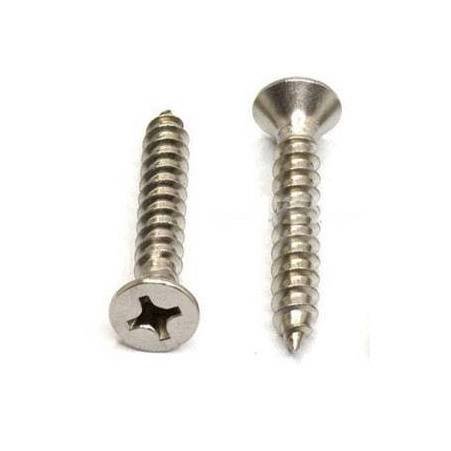In the world of heavy industry—from offshore oil rigs and chemical plants to towering bridges and desalination facilities—fasteners are often the most under-appreciated components. Yet, these bolts, nuts, and screws are all that stand between a secure, operational system and a catastrophic failure.
For decades, engineers have faced a difficult trade-off when selecting materials for these critical components. They could choose austenitic stainless steels, like the common 316 grade, for good corrosion resistance, but they would have to accept relatively low strength. Or they could opt for high-strength carbon steels, but would then need to rely on coatings that can fail or wear away.
This is where duplex stainless steel enters the picture. As a material, it effectively ends this compromise. It offers both high strength and exceptional corrosion resistance, making it one of the most valuable alloys for manufacturing reliable, long-lasting fasteners.
This article explores the unique composition, key properties, and significant advantages of duplex stainless steel bolts.
What Is Duplex Stainless Steel? A “Best of Both Worlds” Microstructure
The name “duplex” simply means “two-part.” This refers directly to the steel’s microscopic crystal structure, which is a mixed, two-phase microstructure containing roughly equal parts of austenite and ferrite.
To understand why this is important, here’s a simple breakdown:
- Austenitic Steel (like 316): This is the most common stainless steel. It has an austenitic structure, which gives it excellent corrosion resistance and formability, but it is not very strong.
- Ferritic Steel (like 430): This is a more basic stainless steel. Its ferritic structure provides good strength and, crucially, makes it highly resistant to a specific type of corrosion called Stress Corrosion Cracking (SCC).
By combining these two structures in a single material, duplex steel inherits the best qualities from both families. It gets the general corrosion resistance and weldability from the austenite, and the high strength and SCC resistance from the ferrite.
The Unique Composition of Duplex Grades
This two-phase structure is achieved through a carefully balanced chemical composition. While different grades exist, the most common (like the popular Grade 2205, or S32205) are built on a few key elements:
- Chromium (Cr): This is the most important element for any stainless steel. Typically present at 20-28%, it forms the “passive layer”—a thin, invisible, self-healing oxide film on the steel’s surface that protects it from rust and corrosion.
- Nickel (Ni): Nickel is a primary “austenite stabilizer.” It helps ensure that the desired 50/50 phase balance is achieved. Duplex steels use less nickel than austenitic grades, which can also make them more stable in price.
- Molybdenum (Mo): This is the secret weapon against pitting and crevice corrosion, especially from chlorides (saltwater, industrial brines). Molybdenum, usually at 1-5%, significantly boosts the steel’s resistance to these localized attacks.
- Nitrogen (N): Nitrogen is a powerful “austenite stabilizer” but also a “strengthening” agent. Adding nitrogen significantly increases the steel’s yield strength and further improves its resistance to pitting.
The combination of chromium, molybdenum, and nitrogen is so important that it’s measured using a formula called the Pitting Resistance Equivalent Number (PREN). A higher PREN value means better corrosion resistance. A standard 316 grade has a PREN of around 25, while a standard duplex 2205 has a PREN around 35 or higher.
Key Properties of Duplex Stainless Steel
This unique composition gives duplex steel a set of mechanical properties that are highly desirable for fasteners.
1. Superior Mechanical Strength
This is the most significant advantage. Standard duplex stainless steels (like S32205) have a yield strength that is roughly double that of common austenitic grades (like 304 or 316).
- Yield Strength of 316 Stainless: ~205 MPa (30,000 psi)
- Yield Strength of Duplex 2205: ~450 MPa (65,000 psi)
For a bolt, this is a game-changer. It means a duplex bolt can handle a much higher clamping force and withstand greater loads than a 316 bolt of the same size.
2. Exceptional Corrosion Resistance
As mentioned, the high levels of Cr, Mo, and N give duplex steel outstanding resistance to general corrosion. But its real power lies in its resistance to two specific, dangerous forms of corrosion.
- Pitting and Crevice Corrosion: In chloride-rich environments (seawater, de-icing salts), 316 stainless steel can suffer from small, deep pits that can compromise the fastener. Duplex steel’s higher PREN makes it far more robust against this type of attack.
- Stress Corrosion Cracking (SCC): This is a “sneak attack” failure. It occurs when a material is under tensile stress (like a tightened bolt) in a specific corrosive environment (especially warm chlorides). The material can look perfectly fine but suddenly fracture. Austenitic steels are very prone to SCC. The ferritic component in duplex steel, however, gives it excellent resistance to SCC, making it a much safer choice for critical, load-bearing applications in warm, salty, or chemical environments.
3. Good Toughness and Ductility
Despite its high strength, duplex steel is not brittle. It maintains very good toughness, meaning it can absorb energy and impact without fracturing. This property is reliably maintained even at low temperatures (down to -50°C), making it suitable for a wide range of climates.
The Key Advantages of Using Duplex Stainless Steel Bolts
When these properties are applied to a fastener, the real-world benefits become clear.
Advantage 1: Higher Strength-to-Weight Ratio and “Down-Gauging”
Because a duplex bolt is twice as strong, engineers can often “down-gauge.” This means they can use a smaller, lighter bolt to achieve the same clamping force as a larger austenitic bolt.
For example, a project might call for a large M30 bolt in 316 stainless. By switching to duplex, the same performance might be achieved with a smaller M24 bolt. This saves material, reduces the overall weight of the assembly (which is critical in shipbuilding and offshore platforms), and can ultimately lower the total project cost.
Advantage 2: Extended Service Life and Reliability
A fastener that fails from corrosion or SCC is a fastener that needs to be replaced. This means costly downtime, expensive labor, and, in critical applications, a major safety hazard.
When specifying components for demanding applications like marine or chemical plants, using duplex stainless steel bolts is a long-term strategic decision. Their resistance to all major forms of corrosion means they last significantly longer, improving safety and drastically reducing maintenance cycles.
Advantage 3: Superior Life-Cycle Cost
It is true that, on a per-bolt basis, a duplex fastener has a higher initial purchase price than a 316 fastener. However, it offers a vastly superior life-cycle cost.
If a 316 bolt in a warm seawater pump fails from SCC after two years, the cost of the emergency shutdown, the labor to extract and replace it, and the lost production will be many times greater than the initial savings. A duplex bolt in the same application might last for the 15- or 20-year design life of the equipment, making it the far more economical choice in the long run.
Where Are These Bolts Used?
- Oil and Gas: On offshore platforms, subsea pipelines, and processing equipment exposed to corrosive sour gas (H2S).
- Marine and Shipbuilding: For propeller shafts, rudders, seawater cooling systems, and deck fittings exposed to constant saltwater spray.
- Chemical Processing: In pressure vessels, tanks, and piping systems that handle acids, chlorides, and other aggressive chemicals.
- Pulp and Paper: In bleaching equipment and other areas that use chloride-based chemicals.
- Infrastructure: In bridges, tunnels, and coastal buildings where corrosion from de-icing salts or sea air is a major concern.




Leave a Reply